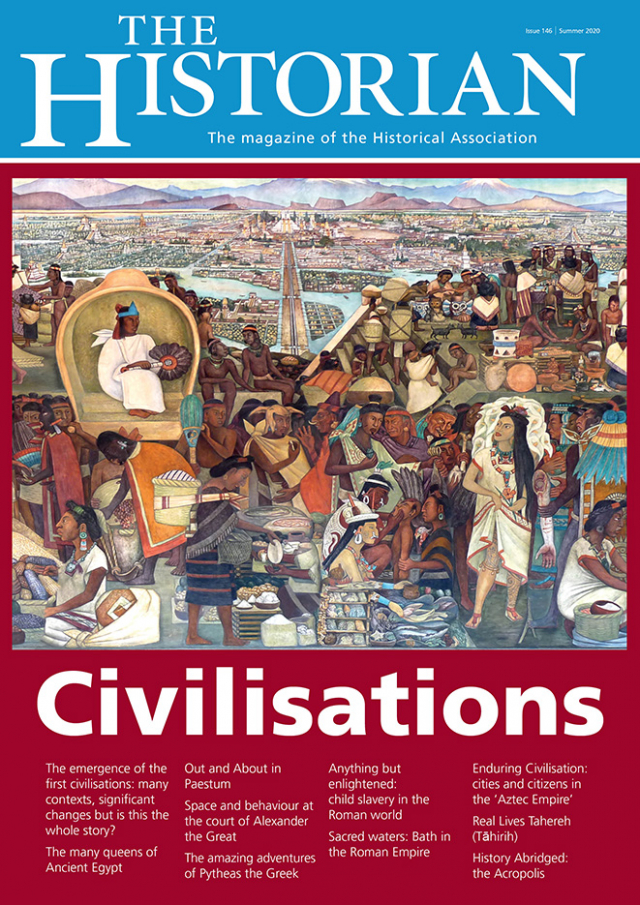The Historian 146: Out now
The magazine of the Historical Association

Editorial: Civilisations
Read The Historian 146: Civilisations
|
Join The Historian editorial board |
I hope Historian readers are keeping safe and well in these difficult times. It might be interesting to see whether future historians regard 2020 as being a ‘civilised’ year when they look back at our global past. Happily, the Historical Association offers many ways to keep the brain active, not the least of which is a thorough reading of this journal, and I am especially grateful to the authors who have written for this edition. They have had to juggle virtual working, contingency planning for the coming year, lack of access to their usual resources, and childcare and have still managed to produce engaging articles.
As quoted by Paul Bracey, in the 1960s Kenneth Clark questioned, ‘What is Civilisation?’, answering, ‘I don’t know, but I think I can recognise it if I see it.’ To illustrate this, Clark made a personal selection from Western art, architecture and philosophy since the Dark Ages, chosen not only on merit but also to capture the imagination visually. The series was to be a standard-bearer for introducing colour broadcasting to the UK. The documentary programmes and the subsequent book were inspiring but, despite their impact, not designed to be a comprehensive study. Paul Bracey, in his much wider-ranging introduction to the subject, explores more useful definitions, and reminds us that civilisations formed all around the globe – in Mesopotamia, Egypt, Crete, the Indus Valley, China and Mesoamerica – from around 3500 BC, long before the Dark Ages.
Included in this edition are features on the Ancient Egyptians, Ancient Greeks, Ancient Romans and the Aztecs, all exploring aspects of societies with advanced and complex cultures, government and religion. In stimulating accounts of their various relationships with the pharaohs, Joyce Tyldesley looks at the roles of queens and consorts in Ancient Egypt. She shows how, from the original Osiris-Isis myth onwards, women in key positions were vital to the survival of the civilisation.
Moving forward in time to the period of Classical Civilisations, Stephen Harrison looks not at the impact of other individuals on Alexander the Great, but at the effect of the spaces he inhabited. Harrison develops a convincing argument that the adoption of symbols of superiority, for example in furnishing, especially those of Persian origin, influenced the behaviour of Alexander and his court and were at least partially responsible for tensions and rivalries within it. Alf Wilkinson describes the achievements of Pytheus the Greek, showing that, without a doubt, he deserves wider recognition in Britain, being the first named person to sail entirely round our island, recording what he saw. Ulrike Roth investigates one of the uncivilised aspects of the Roman Empire, that of child slavery, a study made especially problematic because of terminology – most slaves were referred to, and treated as, children. She includes interesting examples of the wide diversity in the treatment and occupations of enslaved children. Eleri Cousins suggests that the development of Aquae Sulis as a religious sanctuary was initially a gesture of domination, Roman Bath most probably being a sacred place for the local people before Roman occupation. Later, the waters were used by the Romano-British to receive votive offerings and, especially thought-provoking, ‘curse tablets’.
From the early fourteenth century, Tenochtitlan had grown to become an amazing city at the heart of a complex and truly civilised society. As Katherine Bellamy explains, this was sadly not acknowledged by Cortes and his followers, who expected only barbarism, used then, and later, to justify ‘improving’ colonisation. Despite this, the Nahuas’ sense of identity and community with their altepetl is apparent in the historical record and has endured in the indigenous people today.
Among regular features, Trevor James is Out and About in Paestum and Paula Kitching gives us History Abridged on the Acropolis. In future editions we are planning to include non-themed articles, enabling inclusion of more random submissions from members. In keeping with this, Tim Brasier’s Favourite Place is the Arts and Crafts Red House in Bexleyheath, completed in 1860 and Paula Kitching writes about the brave and radical, nineteenth century Real Life of Tahereh (Tāhirih). There will be more information and an appeal for submissions from members in the HA News, due in September.

